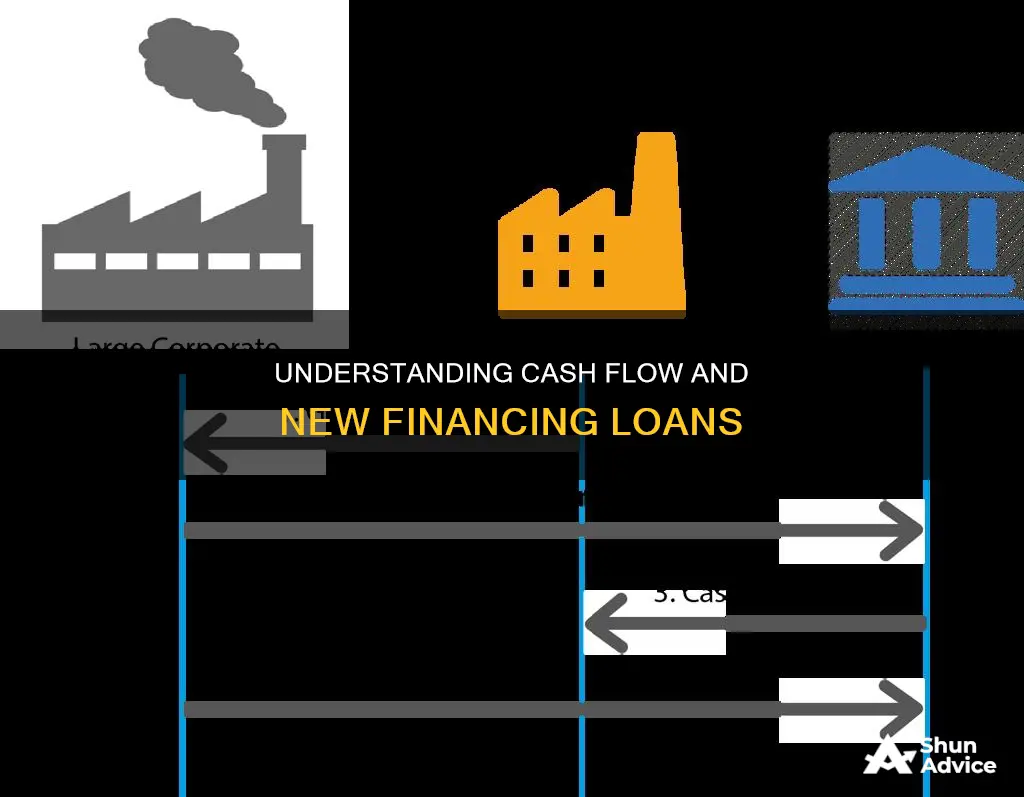
A company's cash flow is influenced by various factors, including its financing activities, such as taking out new loans. Cash flow from financing activities (CFF) is a critical metric that reflects the net amount of funding a company generates or loses over a specific period. It encompasses the inflows and outflows of cash related to debt, equity, and dividend payments. A positive CFF indicates that a company has raised more cash than it has paid out, suggesting growth and expansion. Conversely, a negative CFF may signal debt repayment or liquidity concerns. Understanding a company's CFF provides insights into its financial health, strategy, and ability to service long-term debt obligations.
| Characteristics | Values |
|---|---|
| Definition | Cash flow from financing activities (CFF) is part of a statement that shows how a company raises and repays money through stock issuances and debt payments. |
| Importance | CFF helps investors and analysts understand how a company funds its operations and growth. |
| Formula | CFF = Cash Inflows From Financing – Cash Outflows From Financing |
| Positive CFF | Indicates growth, i.e., more cash was raised than paid out. |
| Negative CFF | Could suggest debt repayment, liquidity concerns, or a healthy debt repayment process. |
| Other Factors | CFF doesn't explain the long-term impact of financing decisions. The context of a company's financial structure and business situation is important for interpretation. |
| Examples | Proceeds from borrowing, issuance of notes, equity offerings, repayment of borrowings, repayment of term loans, dividends paid. |
| Cash Flow Financing | A type of financing where loan instalments are financed directly from a company's income, with future income serving as collateral. |
What You'll Learn

Positive CFF: More cash raised than paid out
A positive CFF indicates that a company has more cash inflows than outflows, which suggests growth. This means that the company has raised more cash than it has paid out, which could indicate that the company is investing in its growth. It is important to note that a positive CFF does not always indicate a healthy financial situation. If a company consistently has a high positive CFF, it may suggest that the company is relying too heavily on external financing rather than its earnings, which could lead to high debt burdens in the future.
A positive CFF can be the result of various financing activities, such as issuing new debt or equity, receiving cash from issuing stock, or taking out loans. For example, a company with a positive CFF of $10 million indicates that it has more cash from financing inflows than outflows, which could be a sign of investing in its growth. However, it is crucial to consider other financial information to determine the company's financial health and long-term profitability prospects.
The cash flow from financing activities (CFF) is a critical component of a company's cash flow statement, providing insights into how a company funds its operations and growth. It helps investors and analysts understand a company's financing strategy and its reliance on external financing. However, it is important to note that CFF does not explain the long-term impact of these actions.
A company's cash flow from financing activities can be calculated by subtracting the outflows from the inflows. This calculation provides the net amount of funding generated by the company during a specific period. While a positive CFF can indicate expansion, it is important to consider the potential risks of relying heavily on external financing.
In summary, a positive CFF indicates that a company has raised more cash than it has paid out, which could suggest growth. However, it is important to consider other financial factors and the potential risks of relying too much on external financing. A company's cash flow from financing activities is a critical aspect of its financial health and can provide valuable insights to investors and analysts.
Bridgecrest Loan Reinstatement: What You Need to Know
You may want to see also

Negative CFF: Debt repayment or liquidity concerns
A negative CFF, or cash flow from financing activities, could indicate that a company is engaging in healthy debt repayment or, conversely, facing liquidity concerns. CFF is one of three core sections of a company's cash flow statement, detailing how a company raises and repays money through stock issuances and debt payments. A positive CFF indicates that a company is raising more money than it is paying out, suggesting growth and expansion. On the other hand, a negative CFF could mean that the company is paying down debt or returning capital to investors.
A negative CFF does not necessarily indicate financial distress. It could suggest that the company is actively reducing its debt levels, which may be a strategic decision to improve its financial health. For example, a company might issue debt to buy out public common equity holders and use the excess cash as incremental liquidity. This could be a sound financial strategy, especially if the cost of capital is skewed more towards the cost of equity than the cost of debt.
However, a negative CFF could also indicate liquidity concerns. Consistent cash outflows may represent strained liquidity, suggesting that the company is struggling to meet its short-term financial obligations. This could be a cause for concern for investors and creditors, as it may indicate that the company is unable to pay its bills or repay debt on time. Therefore, it is essential to consider the company's entire financial structure and business situation to determine if a negative CFF is indicative of financial distress.
It is worth noting that neither a positive nor negative CFF is inherently good or bad. The interpretation of CFF depends on the company's financial strategy and overall context. A consistently high CFF, for instance, could indicate an overreliance on external financing, leading to potentially unmanageable debt burdens in the future. Therefore, investors and analysts must consider various factors, such as the company's industry, risk tolerance, and long-term financial goals, when evaluating CFF.
Campus USA: Loan Options and Opportunities
You may want to see also

CFF and financial health: Understanding a company's financial position
The financial health of a company is critical for all professionals, including business owners, entrepreneurs, employees, and investors. It helps make informed decisions about the organisation's direction and resource allocation. One of the surest ways to assess a company's financial health is through financial statement analysis.
The CFF, or Cash Flow from Financing Activities, is a section of a company's cash flow statement. It details how a company funds its operations and growth and is an important metric for investors and analysts to understand a company's financial health and long-term profitability prospects. A positive CFF means more cash was raised (inflows) than paid out (outflows), indicating growth, while a negative CFF could suggest debt repayment or liquidity concerns.
CFF follows the movement of cash from a company to its investors and creditors, providing insight into a company's financing activities, such as stock issuances, borrowing money, repurchasing shares, and repaying debt. However, it's important to note that CFF has limitations and doesn't explain the long-term impact of financing decisions. Assessing a company's entire financial structure and business situation is crucial to determine if its CFF indicates healthy cash flow or potential financial distress.
To calculate CFF, use the formula: CFF = Cash Inflows From Financing - Cash Outflows From Financing. This calculation helps assess a company's financing strategy and its reliance on external financing. A consistently positive and high CFF could indicate an unhealthy reliance on external financing, leading to high debt burdens. On the other hand, a negative CFF could indicate healthy debt repayment or strained liquidity.
Understanding a company's CFF is vital, as financing decisions can appear beneficial or concerning without knowing the underlying reasons. CFF provides a breakdown of a company's financing activities, helping investors and analysts make informed decisions about the company's financial health and prospects.
Explore Microfilm: BPL's Lending Options
You may want to see also

CFF and investors: How CFF impacts investment decisions
CFF, or Cash Flow from Financing Activities, is a pivotal component of a company's cash flow statement. It sheds light on the company's capital structure, funding decisions, and interactions with shareholders and creditors. CFF reveals the cash inflows and outflows resulting from activities that affect a company's equity and debt, providing valuable insights into how a company raises and repays funds to support its operations and growth.
CFF is important to investors because it shows how a company is funding its operations and growth. A company with a positive CFF is in good financial health as it can measure the company's ability to generate cash from its financing activities. A positive CFF indicates that a company is raising capital to grow and expand, while a negative CFF might indicate that a company is aiming to reduce its debt levels or buy back shares, returning value to investors.
CFF can also provide analysts with insight into management's financial strategy and any shifting trends. For example, raising capital might indicate that management is changing its capital structure and increasing its risk tolerance. CFF also sheds light on a company's dividend policy and its commitment to rewarding shareholders. A positive CFF from dividends paid indicates a company's willingness to distribute profits to its shareholders.
While CFF is a valuable metric, it should be interpreted alongside other financial indicators. A company may have valid reasons for raising debt or repurchasing stock, and the context of these decisions is crucial for a comprehensive analysis. Investors and analysts need to look at CFF alongside other financial information to determine a company's financial health and long-term profitability prospects.
Capital One and Trailer Loans: What You Need to Know
You may want to see also

CFF calculation: Inflows and outflows
CFF, or Cash Flow from Financing Activities, is a section of a company's cash flow statement. It details the net flows of cash used to fund the company, showing how a company raises and repays money through stock issuances and debt payments. It is calculated by subtracting the outflows from the inflows.
Inflows
Inflows refer to the cash that comes into the company. This can include:
- Issuing debt or equity
- Borrowing money
- Receiving cash from issuing stock
Outflows
Outflows refer to the cash that leaves the company. This can include:
- Repaying debt or loans
- Paying dividends
- Repurchasing shares or stock
Calculation
The formula for calculating CFF is:
CFF = Cash Inflows From Financing - Cash Outflows From Financing
For example, if a company has $40 million in inflows from issuing debt, and $20 million in outflows from repaying debt and $10 million in outflows from paying dividends, the CFF would be:
CFF = $40 million - ($20 million + $10 million) = $10 million
A positive CFF indicates that a company has more cash inflows than outflows, which could mean it is investing in growth. However, relying too much on financing can be risky. On the other hand, a negative CFF could indicate healthy debt repayment or a return of value to investors. It is important to consider CFF in the context of a company's entire financial structure to determine its significance.
Borrowing Less: Does It Affect Loan Demand?
You may want to see also
Frequently asked questions
Cash flow from financing activities (CFF) is a section of a company's cash flow statement that details how a company raises and repays money through stock issuances and debt payments. It helps investors and analysts understand how a company funds its operations and growth.
A positive CFF means more cash was raised than paid out, indicating growth. A negative CFF could suggest debt repayment or liquidity concerns. However, neither a positive nor negative CFF is inherently good or bad, as it depends on the company's financial strategy and situation.
New financing loans can increase cash flow by providing a source of incoming cash flow. However, if a loan is taken to bridge a cash shortage, it may be seen as a negative. It's important to consider the purpose of the loan and its impact on the company's financial position.
Investors can use CFF to assess a company's short-term liquidity and ability to service long-term debt. A company that regularly repays loans may be in a stronger financial position. Additionally, creditors consider a company's track record of debt repayment and its leverage when evaluating loan decisions.







